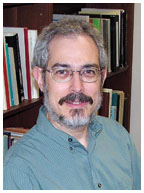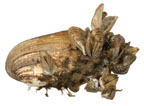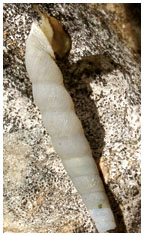|
Web Exclusives: Alumni Spotlight
November 7, 2007: PROFILE - Gary Rosenberg ’81 Gary Rosenberg ’81 is surrounded by shells in the museum of Philadelphia’s Academy of Natural Sciences. They are housed in a labyrinth of grayish-white cabinets that shelter a collection of roughly 10 million shells and other mollusks, including snail shells he collected from Jamaica that look like white icicles and black-striped zebra mussels that he found in Ukraine. Chair-man of the academy’s malacology (i.e., mollusk) department, Rosenberg collects, names, and organizes shells and looks to them for clues to environmental and evolutionary questions. Until 10 years ago, much of the information about mollusks — which range from minuscule clams and snails to large and intelligent octopuses — was locked up in books that were generally accessible only to specialists, says Rosenberg. Pictures, descriptions, and information about habits, habitats, and geographic ranges of species often were not included in the field guides used by amateurs. In an effort to democratize the field, Rosenberg has been using databases and interactive online keys to place knowledge at the fingertips of scientists, students, and hobbyists. In 1990, Rosenberg began creating the first online mollusk database, called Malacolog, in order to store information about mollusks in one place and, more importantly, because he had a difficult time knowing if certain specimens already had been found and classified. Today, Malacolog (www.malacolog.org) includes data on more than 6,000 snails, slugs, and other mollusks that reside between Antarctica and Greenland. Last year, Malacolog helped Rosenberg and his colleagues examine an evolutionary question: Whether large-bodied animals become smaller and small-bodied animals become larger when they colonize the deep sea. This evolutionary change in size has been observed among elephants on islands, and by analyzing data in Malacolog, the scientists found that this also happens to mollusks in the deep sea. Rosenberg also has helped develop an interactive key to the land snails of Jamaica that gives Jamaica’s scientists and citizens a simple way to identify species living in their own backyard. Collecting and organizing shells have been lifelong interests for Rosenberg. As a 5-year-old, he carried buckets of clamshells back from the New Jersey beaches he visited with his grandparents. His collector’s instinct also prodded him to amass stamp and coin collections, and he regularly gathered rocks and acorns on his way home from school. But a passion for shells stuck. Rosenberg, who majored in geo-logy at Princeton, says, “I’m pursuing a hobby that became a profession. I still enjoy working with the shells because of their beauty.” Rosenberg is contemplating tackling a global list of all the known
mollusks. Species can serve as early alerts of environmental changes,
but, as Rosenberg says, “If you can’t identify the species,
you’re going to miss the warning signs.” By Sabina Borza Sabina Borza is an editor and freelance writer based in New Jersey.
|
||



